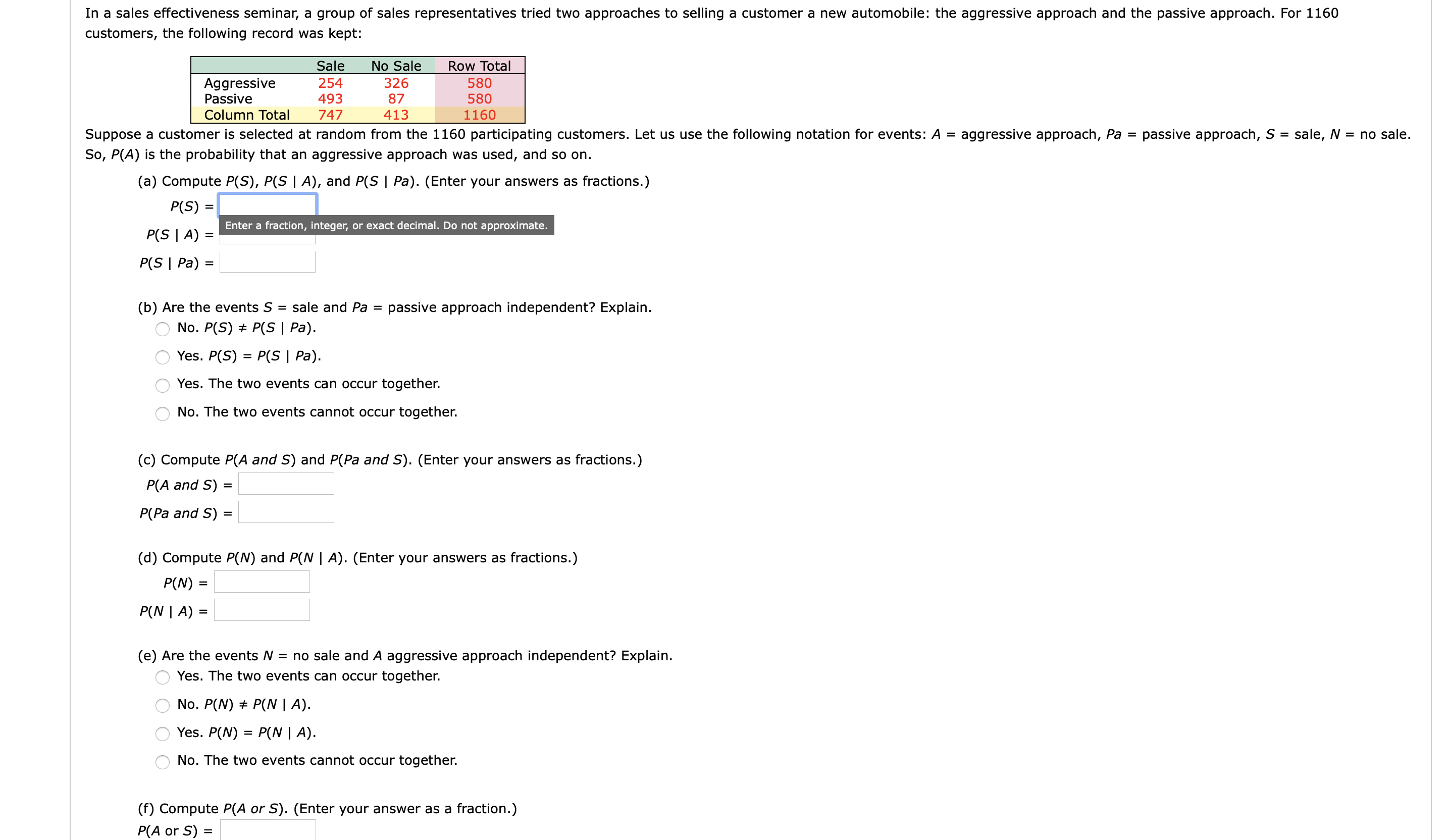In a sales effectiveness seminar, a group of sales representatives tried two approaches to selling a customer a new automobile: the aggressive approach and the passive approach. For 1160 customers, the following record was kept: Sale No Sale Row Total 254 326 580 Aggressive Passive 87 580 493 Column Total 413 747 1160 passive approach, S = sale, N = no sale. Suppose a customer is selected at random from the 1160 participating customers. Let us use the following notation for events: A = aggressive approach, Pa = So, P(A) is the probability that an aggressive approach was used, and so on. (a) Compute P(S), P(S | A), and P(S | Pa). (Enter your answers as fractions.) P(S) = Enter a fraction, integer, or exact decimal. Do not approximate. P(S | A) = P(S | Pa) = sale and Pa = (b) Are the events S passive approach independent? Explain. No. P(S) + P(S | Pa). Yes. P(S) = P(S | Pa). Yes. The two events can occur together. No. The two events cannot occur together. (c) Compute P(A and S) and P(Pa and S). (Enter your answers as fractions.) P(A and S) = %3D P(Pa and S) = (d) Compute P(N) and P(N | A). (Enter your answers as fractions.) P(N) P(N | A) = (e) Are the events N = no sale and A aggressive approach independent? Explain. Yes. The two events can occur together. No. P(N) + P(N | A). Yes. P(N) = P(N | A). No. The two events cannot occur together. (f) Compute P(A or S). (Enter your answer as a fraction.) P(A or S) = %3D
In a sales effectiveness seminar, a group of sales representatives tried two approaches to selling a customer a new automobile: the aggressive approach and the passive approach. For 1160 customers, the following record was kept: Sale No Sale Row Total 254 326 580 Aggressive Passive 87 580 493 Column Total 413 747 1160 passive approach, S = sale, N = no sale. Suppose a customer is selected at random from the 1160 participating customers. Let us use the following notation for events: A = aggressive approach, Pa = So, P(A) is the probability that an aggressive approach was used, and so on. (a) Compute P(S), P(S | A), and P(S | Pa). (Enter your answers as fractions.) P(S) = Enter a fraction, integer, or exact decimal. Do not approximate. P(S | A) = P(S | Pa) = sale and Pa = (b) Are the events S passive approach independent? Explain. No. P(S) + P(S | Pa). Yes. P(S) = P(S | Pa). Yes. The two events can occur together. No. The two events cannot occur together. (c) Compute P(A and S) and P(Pa and S). (Enter your answers as fractions.) P(A and S) = %3D P(Pa and S) = (d) Compute P(N) and P(N | A). (Enter your answers as fractions.) P(N) P(N | A) = (e) Are the events N = no sale and A aggressive approach independent? Explain. Yes. The two events can occur together. No. P(N) + P(N | A). Yes. P(N) = P(N | A). No. The two events cannot occur together. (f) Compute P(A or S). (Enter your answer as a fraction.) P(A or S) = %3D
Holt Mcdougal Larson Pre-algebra: Student Edition 2012
1st Edition
ISBN:9780547587776
Author:HOLT MCDOUGAL
Publisher:HOLT MCDOUGAL
Chapter11: Data Analysis And Probability
Section11.4: Collecting Data
Problem 6E
Related questions
Question

Transcribed Image Text:In a sales effectiveness seminar, a group of sales representatives tried two approaches to selling a customer a new automobile: the aggressive approach and the passive approach. For 1160
customers, the following record was kept:
Sale
No Sale
Row Total
254
326
580
Aggressive
Passive
87
580
493
Column Total
413
747
1160
passive approach, S = sale, N = no sale.
Suppose a customer is selected at random from the 1160 participating customers. Let us use the following notation for events: A =
aggressive approach, Pa =
So, P(A) is the probability that an aggressive approach was used, and so on.
(a) Compute P(S), P(S | A), and P(S | Pa). (Enter your answers as fractions.)
P(S) =
Enter a fraction, integer, or exact decimal. Do not approximate.
P(S | A) =
P(S | Pa) =
sale and Pa =
(b) Are the events S
passive approach independent? Explain.
No. P(S) + P(S | Pa).
Yes. P(S) = P(S | Pa).
Yes. The two events can occur together.
No. The two events cannot occur together.
(c) Compute P(A and S) and P(Pa and S). (Enter your answers as fractions.)
P(A and S) =
%3D
P(Pa and S) =
(d) Compute P(N) and P(N | A). (Enter your answers as fractions.)
P(N)
P(N | A) =
(e) Are the events N = no sale and A aggressive approach independent? Explain.
Yes. The two events can occur together.
No. P(N) + P(N | A).
Yes. P(N) = P(N | A).
No. The two events cannot occur together.
(f) Compute P(A or S). (Enter your answer as a fraction.)
P(A or S) =
%3D
Expert Solution
This question has been solved!
Explore an expertly crafted, step-by-step solution for a thorough understanding of key concepts.
This is a popular solution!
Trending now
This is a popular solution!
Step by step
Solved in 6 steps with 4 images

Recommended textbooks for you

Holt Mcdougal Larson Pre-algebra: Student Edition…
Algebra
ISBN:
9780547587776
Author:
HOLT MCDOUGAL
Publisher:
HOLT MCDOUGAL

Glencoe Algebra 1, Student Edition, 9780079039897…
Algebra
ISBN:
9780079039897
Author:
Carter
Publisher:
McGraw Hill

Holt Mcdougal Larson Pre-algebra: Student Edition…
Algebra
ISBN:
9780547587776
Author:
HOLT MCDOUGAL
Publisher:
HOLT MCDOUGAL

Glencoe Algebra 1, Student Edition, 9780079039897…
Algebra
ISBN:
9780079039897
Author:
Carter
Publisher:
McGraw Hill